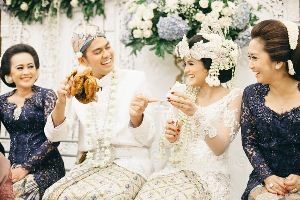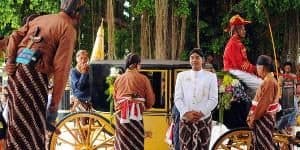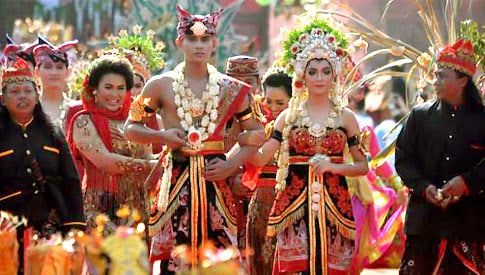Marriage in Indonesia is something sacred and is usually celebrated with specials tradition. The diverse Indonesian culture also influences marriage arrangements. Well, in Indonesia, there are some unique wedding customs that are difficult to find elsewhere.
1. Requirement to Plant Trees
 If you ever come to Gunung Kidul, Yogyakarta then you’d surely know that the area of Gunung Kidul is dry and arid. In response to these circumstances, the community then has a unique way for marriage to also has some benefits for the environment. The trick is to plant the teak tree seeds as one of the requirements for marriage. This wedding custom is performed in the village of Bohol, Rongkop, Gunung Kidul and is referred to as Kromojati marriage tradition.
If you ever come to Gunung Kidul, Yogyakarta then you’d surely know that the area of Gunung Kidul is dry and arid. In response to these circumstances, the community then has a unique way for marriage to also has some benefits for the environment. The trick is to plant the teak tree seeds as one of the requirements for marriage. This wedding custom is performed in the village of Bohol, Rongkop, Gunung Kidul and is referred to as Kromojati marriage tradition.
Every villager of Bohol who is going to get married is required to plant teak seedlings at least 5 seeds in critical lands spreading in Dusun of Wuru and Gamping. This rule has been implemented since 2007.
See Also:
2. “Kidnapping” the Bride to Marry
 The term elopement has been known to our society from the past when couples who want to marry for certain reasons escaped from their parents to carry out the marriage in secrets. This custom is known in two tribes in Indonesia, namely the adat Kawin Colong Tribe Osing, Banyuwangi and Kawin Cawik Sasak Lombok.
The term elopement has been known to our society from the past when couples who want to marry for certain reasons escaped from their parents to carry out the marriage in secrets. This custom is known in two tribes in Indonesia, namely the adat Kawin Colong Tribe Osing, Banyuwangi and Kawin Cawik Sasak Lombok.
Both have the same tradition, that the bride is “kidnapped” or taken from the house of her parents to the house of men without the knowledge of her parents. In Sasak tribe custom, if the kidnapping process is caught, then the man will be fine.
See Also:
3. Calculation of dowry
 For some tribal cultures in Indonesia, dowries in marriage are mandatory and the assessment indicators may vary for each tribal custom. An example is Padang who calls the dowry money as Japuik money. Measuring tool for Japuik is ameh. One ameh worth 2.5 grams of gold. The price can vary depending on the social strata and the couple’s education.
For some tribal cultures in Indonesia, dowries in marriage are mandatory and the assessment indicators may vary for each tribal custom. An example is Padang who calls the dowry money as Japuik money. Measuring tool for Japuik is ameh. One ameh worth 2.5 grams of gold. The price can vary depending on the social strata and the couple’s education.
Different people also usually have to buy clans name first and the price is adjusted by the agreement with the family. Not just Batak, the calculation of dowries that are adapted to the social strata and education of a person is also present in Bugis tribe and Sasak tribe Lombok. Just like indigenous Batak tribe, the cost is quite expensive to be worn if the man is not the original of both tribes. The average can reach 50- 200 million rupiah for the calculation of dowry.
See Also:
4. Javanese “pingitan” Culture
 In the marriage customs of Solo, Yogyakarta and some other parts of Java the custom of pingitan is still done to the bride. The bride is forbidden to meet the groom for 1 month for the longest period of time, it is done to maintain the sanctity of each bride and groom candidate.
In the marriage customs of Solo, Yogyakarta and some other parts of Java the custom of pingitan is still done to the bride. The bride is forbidden to meet the groom for 1 month for the longest period of time, it is done to maintain the sanctity of each bride and groom candidate.
Pingitan is not filled with silence activities but friends from each party will try to enliven their mood, the bride and groom are encouraged to pray and beg God to marry in accordance with the plan and running smoothly.
See Also:
5. Proposing to the Groom
 In the tradition of Minang traditional marriage, the bride’s family will come to the groom to ask for the proposal. After the application is accepted, the procession is then continued by exchanging the sign as a symbol of the unification.
In the tradition of Minang traditional marriage, the bride’s family will come to the groom to ask for the proposal. After the application is accepted, the procession is then continued by exchanging the sign as a symbol of the unification.
The bride’s family came with cakes and fruits and betel nut, completely arranged in kampia (Bag made of pandan leaves) served for the tasting of the family of the men. Then followed by exchanging heirloom objects such as kris, and custom fabric.
See Also:
6. Determining Good Date to Marry
 Determining good days, hours and dates is a must in relation to China’s customary traditions in Indonesia. The wedding party is not just a temporary symbol signifying that the couple has been officially in bond. But for the elderly families who are very concerned about customs, they consider that Chinese traditional marriage must be sacred. Not just for both couples, but also the bond between the two families.
Determining good days, hours and dates is a must in relation to China’s customary traditions in Indonesia. The wedding party is not just a temporary symbol signifying that the couple has been officially in bond. But for the elderly families who are very concerned about customs, they consider that Chinese traditional marriage must be sacred. Not just for both couples, but also the bond between the two families.
The delivered goods usually also symbolize sustainability, fertility and also happiness for the couple. Uniquely enough of the proposal in this custom there is the number of nominal 9 (jiu) or 8 (fat) which became the main symbol and lasting happiness for the bride and groom.
See Also:
7. Sing a Poetry during Sawer
 Sawer in Sundanese means the fall of water from the higher tile to lower one. The ceremony begins by singing a poem that has a spiritual value to educate the bride and groom. Then, the bride and groom will receive a bag consisting of rice, loose change, candy, and turmeric. Where rice represents prosperity and prayer that is addressed to the bride in order to gain prosperity.
Sawer in Sundanese means the fall of water from the higher tile to lower one. The ceremony begins by singing a poem that has a spiritual value to educate the bride and groom. Then, the bride and groom will receive a bag consisting of rice, loose change, candy, and turmeric. Where rice represents prosperity and prayer that is addressed to the bride in order to gain prosperity.
Coins are the symbol of hope that can be achieved by the bride by sharing with the poor. While confectionery symbolizes the meaning of sweet life and turmeric which is a symbol of glory. Sawer has the meaning of conveying the advice of both bride and groom parents. This ceremony also symbolizes the love and affection of both parents that are endless.
See Also:
8. Bainai Night, Minang Tribe
 The Bainai Night Procession which became the celebration of the bride’s last night was very popular. Bainai Night is a procession of applying a fine concoction of henna leaves to the nails of the prospective bride. Bainai is an expression of affection and blessing from the elders for the bride’s family.
The Bainai Night Procession which became the celebration of the bride’s last night was very popular. Bainai Night is a procession of applying a fine concoction of henna leaves to the nails of the prospective bride. Bainai is an expression of affection and blessing from the elders for the bride’s family.
In addition, in some areas of Minangkabau, the bride-to-be is also taken for a bath in the afternoon or evening and represented by elders and both parents that will splash the fragrant water of seven flowers to the prospective bride
See Also:
9. Nyantri Tradition, Kraton Jogja
 In Jogja Sultan’s culture, the groom should be at the bride’s residence, two or three days before the wedding day. This tradition is called nyantri tradition. Because in ancient times usually between bride and groom they aren’t yet familiar with each other, it even could be that their first-day of the meeting is on their wedding day. This is what often provoke the event of a groom who leaves from marriage.
In Jogja Sultan’s culture, the groom should be at the bride’s residence, two or three days before the wedding day. This tradition is called nyantri tradition. Because in ancient times usually between bride and groom they aren’t yet familiar with each other, it even could be that their first-day of the meeting is on their wedding day. This is what often provoke the event of a groom who leaves from marriage.
Therefore, to prevent the man from running away, then he was asked to nyantri in the bride’s residence. Not that the groom lives in the bride’s house, but usually the groom is placed to the house of a relative or the neighbor.
Other Wedding Traditions (10-17)
Apart from explanation above, there are other wedding traditions in Indonesia which still developed until now, as follows:
10. Seller Buyer Transaction in Balinese Wedding
The tradition of buying and selling done in the traditional wedding of Bali is one stage in the celebration of the marriage. Where the basket brought by the prospective bride and then will be purchased by the prospective groom. The activity is an analogy of married life that must complement, give and fill, to achieve the desired goals.
11. The tradition of not going to the Bathroom
This tradition is in the Tidung Kalimantan. This tradition of prohibiting to defecating and urinating is done by both bride and groom. Before the marriage takes place, the bride and groom are prohibited to going to the toilet for 3 days 3 nights or 72 hours. To anticipate that, they must be willing to eat and drink less for 3 days. Alternately the family will supervise the bride and groom not to go to the bathroom. This tradition is done because it is believed they will live happily and endowed with abundant children and sustenance.
See Also:
12. Ciou Tau
In ethnic Chinese marriage, there is a unique tradition called ciou tau. There are a number of processions that are held in this ciou tau, but the unique things are that the brides and groom are sitting in the chair over the rice and their hair are tied like a bun. Then the relatives gave the red envelope, which was placed on a bushel (a kind of wooden pot) containing various items, including rice, mirrors, scissors, comb etc. The bride and groom will sit on the top of the chair with the symbol yin in turn.
13. Anrio Tallu
There is a unique tradition when the wedding are going to be held. The wedding procession begins with a drum beating called panruppai to battu with a traditional musical instrument of bamboo called pui pui as a welcome sign for the arrival of invited guests and relatives who come to the wedding.
14. Palang Pintu
In Betawi culture, there is a unique tradition before the wedding ceremony that is the Palang Pintu tradition. In this tradition, the entourage of the groom before meeting the bride should show martial arts and reciprocate rhymes with envoys of the bride’s family. In this tradition, the bridegroom also shows his ability to read the Qur’an
15. Peusijeuk
The tradition of this kind is from Nanggroe Aceh Darusallam, it is a gift of blessing to the bride and groom by sprinkling three types of water coming out of the leaves of seunikeuk, sambo, naleung root, maneekmano, pulut and ongaca. This tradition is led by religious leaders who will also pray for the bridegroom wellbeing
16. Mutus Kato dan Berasan
Mutus Karo and berasan are the traditions of the people of Palembang before the wedding. In this tradition, the bride and groom meet for the fourth time with the bride’s family while carrying the tenong and some messengers who deliver poetry or pantun.
17. Midodareni
This tradition comes from Java. In this midodareni the bride must be in her bridal chamber, which is filled with a pair of twin mayang, a pair of priuk filled with spices, a pair of jars filled with holy water, pandan leaves, grated kencur, laos, kaffir lime and perfume and she should not sleep. All these objects are placed under the bride’s bed. It is believed that on that night the angel will come down to beautify the bride.
See Also:
The unique tradition of marriage in Indonesia is the signs of the decades of cultural inheritance that takes place here. The tradition that must be preserved so as to not erode over time by the influence of western culture. To appreciate this tradition by learning it and to also practice it is the only way to make sure that people outside will respect what makes Indonesia truly unique in the first place.
